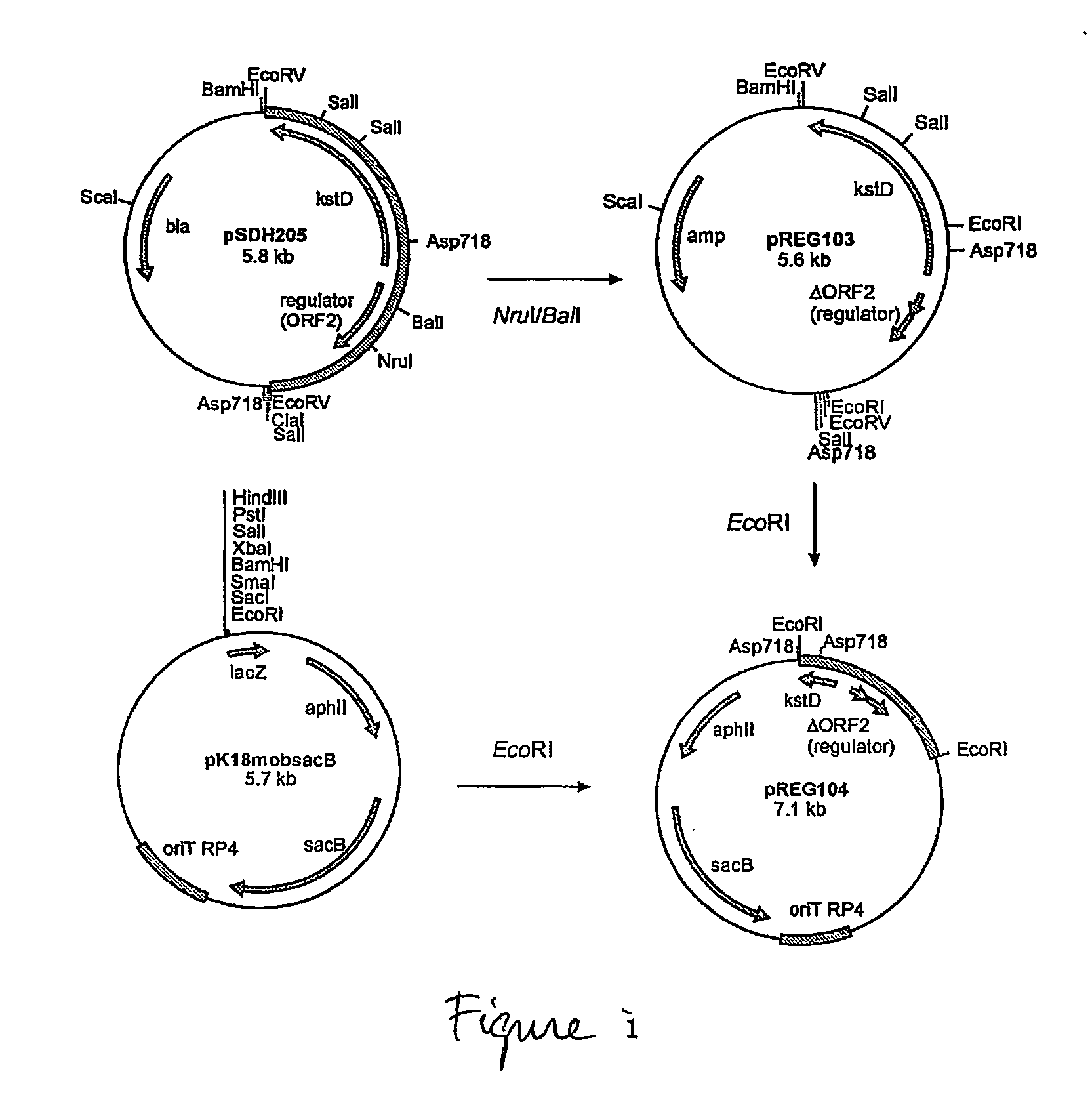New expression system from rhodococcus
a technology of rhodococcus and rhodococcus, applied in the field of new expression system of rhodococcus, can solve the problems of insufficient strains in industrial processes, negative effects on bioconversion efficiency, and obsolete use of chemical agents to block certain pathways
- Summary
- Abstract
- Description
- Claims
- Application Information
AI Technical Summary
Benefits of technology
Problems solved by technology
Method used
Image
Examples
example 1
Constitutive Expression of kstD Following kstR Unmarked Gene Deletion
[0063] Mutagenic plasmid pREG104 was constructed for unmarked gene deletion of kstR, the gene encoding a transcription regulator of the kstD gene (encoding 3-ketosteroid Δ1-dehydrogenase KSTD1) in Rhodococcus erythropolis SQ1 (FIG. 1). Briefly, pSDH205 (Van der Geize, R. et al. 2000. Appl. Environ. Microbiol. 66:2029-2036) was digested with restriction enzymes NruI and BalI followed by self-ligation, resulting in plasmid pREG103. An EcoRI DNA fragment of pREG103, containing the kstR gene deletion was subsequently cloned into EcoRI digested pK18mobsacB vector, resulting in pREG104. Unmarked kstR gene deletion mutant R. erythropolis RG10 was isolated from R. erythropolis SQ1 using pREG104 via the sacB counter-selection method as described (Van der Geize R. et al. 2001. FEMS Microbiol. Lett. 205:197-202). Genuine kstR gene deletion was confirmed by the polymerase chain reaction (PCR) using forward primer (REG-REV) 5α...
example 2
Constitutive Expression of KstD2 for Microbial Steroid Δ1-dehydrogenation
[0065] A kstR gene deletion mutant strain of R. erythropolis RG9 (Van der Geize, R. et al. 2002. Mol. Microbiol. 45:1007-1018) was constructed, designated R. erythropolis RG17, using pREG104 (FIG. 1, see example 1). Strain RG17 thus is a kstD kstD2 kshA1 kstR quadruple gene deletion mutant, lacking 3-ketosteroid Δ1-dehydrogenase (KSTD1 and KSTD2) and 3-ketosteroid 9α-hydroxylase (KSE) activities, in addition to the transcription regulator of the kstD promoter. Due to the kstD kstD2 kshA phenotype of this mutant, strain RG17 is completely blocked in metabolizing 4-androstene-3,17-dione (AD), 1,4-androstadiene-3,17-dione (ADD) and 9α-hydroxy-4-androstene-3,17-dione (9OHAD).
[0066] A Rhodococcus expression vector was constructed for the expression of genes under control of the kstD promoter of R. erythropolis SQ1 (Van der Geize, R. et al. 2000. Appl. Environ. Microbiol. 66:2029-2036). Using the kstD promoter, exp...
example 8
Expression of kshA Isogene kshA2 Complements the kshA Mutant Phenotype
[0070] A homologue of the kshA gene of R. erythropolis SQ1 (Van der Geize, R. et al. 2002. Mol. Microbiol. 45:1007-1018) was identified following nucleotide sequencing of DNA fragments isolated by complementation experiments of UV-induced Rhodococcus mutants. R. erythropolis SQ1 contains at least two kshA isogenes, which were designated kshA and kshA2.
[0071]R. erythropolis RG2, a kshA gene deletion mutant of R. erythropolis SQ1 (Van der Geize, R. et al. 2002. Mol. Microbiol. 45:1007-1018), does not show growth on mineral agar plates (1 g·l−1 NH4NO3, 0.25 g·l−1 K2HPO4, 0.25 g·l−1 MgSO4.7H2O, 5 mg·l−1 NaCl, 5 mg·l−1 FeSO4.7H2O (pH 7.2), 1.5% agar) supplemented with AD (0.25 g·l−1) as sole carbon and energy source. Thus, kshA2 is not expressed under these growing conditions in R. erythropolis RG2.
[0072] The kshA2 gene was placed under control of the kstD promoter in pRESX. In order to achieve this, the kshA2 gene ...
PUM
| Property | Measurement | Unit |
|---|---|---|
| concentration | aaaaa | aaaaa |
| resistance | aaaaa | aaaaa |
| length | aaaaa | aaaaa |
Abstract
Description
Claims
Application Information
 Login to View More
Login to View More - R&D
- Intellectual Property
- Life Sciences
- Materials
- Tech Scout
- Unparalleled Data Quality
- Higher Quality Content
- 60% Fewer Hallucinations
Browse by: Latest US Patents, China's latest patents, Technical Efficacy Thesaurus, Application Domain, Technology Topic, Popular Technical Reports.
© 2025 PatSnap. All rights reserved.Legal|Privacy policy|Modern Slavery Act Transparency Statement|Sitemap|About US| Contact US: help@patsnap.com


